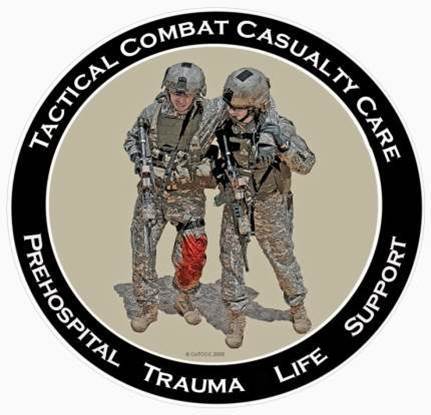PLDS-230: Tactical Combat Casualty Care (TCCC / TC3)
(24 hours / 3 days, 8 hours each - includes scenario exercises)
Teaches prehospital battlefield medical skills, from the official military TC3 courseware, now used by all services in the U.S. military, conventional as well as Special Ops.
Course Description
This course is at least 24-hours long (3 days, 8 hours each) and includes classroom time and scenario-based field excercises learning to increase the suvivability of combat casualties. Students learn:
- Differences between military and civilian pre-hospital trauma care.
- Key factors influencing combat casualty care.
- How TCCC developed.
- Three phases of care in TCCC (Care Under Fire, Tactical Field Care, Tactical Evacuation Care).
- Care Under Fire (CUF)
- Role of firepower supremacy in the prevention of combat trauma.
- Techniques that can be used to quickly move casualties to cover while the unit is engaged in a firefight.
- Rationale for early use of a tourniquet to control life-threatening extremity bleeding during Care Under Fire.
- Appropriate application of the Combat Application Tourniquet (CAT) to the arm and leg.
- Why immobilization of the cervical spine is not a critical need in combat casualties with penetrating trauma to the neck.
- Tactical Field Care (TFC)
- Common causes of altered states of consciousness on the battlefield.
- Why a casualty with an altered state of consciousness should be disarmed.
- Airway control techniques and devices appropriate to the Tactical Field Care phase.
- Recommended procedure for surgical cricothyroidotomy.
- Criteria for the diagnosis of tension pneumothorax on the battlefield.
- Diagnosis and initial treatment of tension pneumothorax on the battlefield.
- Appropriate procedure for needle decompression of the chest.
- Progressive strategy for controlling hemorrhage in tactical field care.
- Correct application of Combat Gauze.
- Appropriate procedure for initiating a rugged IV field setup.
- Rationale for obtaining intraosseous access in combat casualties.
- Appropriate procedure for initiating an intraosseous infusion.
- Tactically relevant indicators of shock in combat settings.
- Pre-hospital fluid resuscitation strategy for hemorrhagic shock in combat casualties.
- Management of penetrating eye injuries in TCCC.
- How to prevent blood clotting problems from hypothermia.
- Appropriate use of pulse oximetry in pre-hospital combat casualty care.
- Pitfalls associated with interpretation of pulse oximeter readings.
- Recommended agents for pain relief in tactical settings along with their indications, dosages, and routes of administration.
- Rationale for early antibiotic intervention on combat casualties.
- Factors involved in selecting antibiotic drugs for use on the battlefield.
- Management of burns in TFC.
- Cardiopulmonary resuscitation is not generally used for cardiac arrest in battlefield trauma care.
- Procedure for documenting TCCC care with the TCCC Casualty Card.
- Three ISAF categories for evacuation priority.
- Nine items in a MEDEVAC request.
- Rules of thumb for calling for Tactical Evacuation and the importance of careful calculation of the risk/benefit ratio prior to initiating the call.
- Appropriate procedures for providing trauma care for wounded hostile combatants.
- Tactical Evacuation Care (TEC)
- Differences between MEDEVAC and CASEVAC.
- Differences between Tactical Field Care and Tactical Evacuation Care.
- Additional assets that may be available for airway management and electronic monitoring.
- Indications for, and administration of, Tranexamic Acid during tactical evacuation.
- Management of moderate/severe TBI during tactical evacuation.
- Additional options that may be available in TEC for fluid resuscitation.
- Indications and administrative controls applicable to giving blood component therapy and fresh whole blood in the field.
Students will take a Student Examination.
Course Prerequisites
The are no mandatory prerequisites for taking this course. The course contains material that is extremely graphic in nature, including still and video imagery of actual wounds, and is suitable only for adults. Students would benefit from being familiar with basic first aid, such as the material learned in American Red Cross First Aid, CPR, and AED courses.
Course Materials Provided
The student's following course materials are included in the cost of the course. Each student will receive a packet, which includes*:
- Student Pre-Test
- Training Medical Supplies (For use during the course)
- Student Skill Worksheets
- Course Completion Certificate
- Course Evaluation Sheet
- Student Exam
Course Packing List
Participation requires that the student provide the following equipment, which is not included in the cost of the course. Students who arrive without a piece of non-optional equipment listed below will be asked to leave, may be unable to participate in certain sections of instruction, or may be able to purchase suitable replacements on the premises, at our sole discretion. Students should pack:
NOTE: NO LIVE AMMO IS TO BE BROUGHT INTO THE CLASSROOM.
- Load Bearing Equipment / Plate Carrier
- Pen & Paper
- Protective eyewear
- Hat
- Sturdy closed-toe shoes - no flip-flops or sandals
- Clothing appropriate for season/weather outdoors (long sleeves and pants recommended year-round, for exercises)
- Cleaning kit for your firerarm
- (OPTIONAL) Pistol/Rifle/Shotgun
- (OPTIONAL) Snacks
- (OPTIONAL) Drinks
Minimum Class Size Requirement
Due to the logistical efforts required to conduct this course, a minimum of 8 students must be registered and pre-paid, as of 72 hours before the scheduled time and date, for the course to be held. If this minimum requirement can not be met, the course will be rescheduled to a future date.
* Student Packet contents subject to change without notice.
(Lesson Plan 2nd edition, 2012, 09/17)
